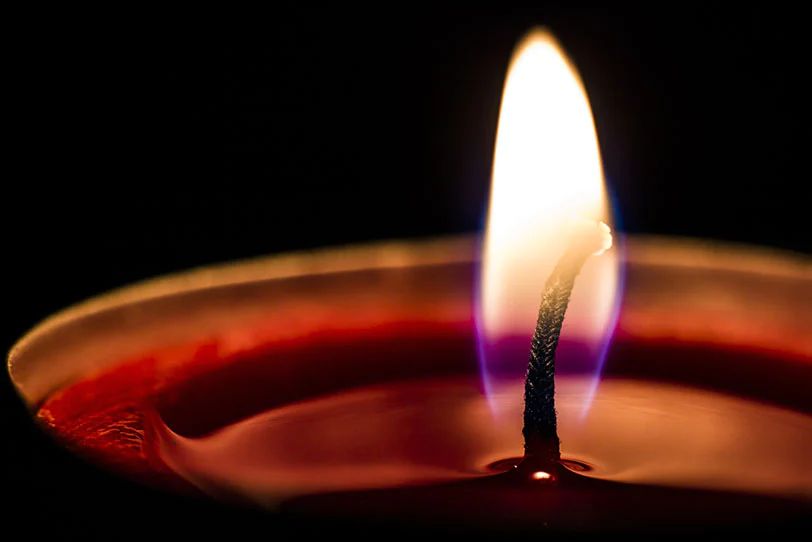What Happens If Your Wick Is Too Small?
What is a Wick?
A wick is a specially designed component in candles, oil lamps, and other fuel-burning devices that serves to deliver fuel to the flame. It acts as a conduit to bring liquefied wax or oil via capillary action from the fuel reservoir to the site of combustion at the wick top.
Wicks are typically made from materials like cotton, paper, or wood that can “wick” or draw liquid fuels up through their strands. As the fuel is burned at the wick top, the heat melts more of the solid fuel which is then drawn up the wick to continue feeding the flame. This capillary action process repeats to sustain the flame as long as fuel remains.
Wicks are essential components in candles, oil lamps, tiki torches, and other devices to control and sustain burning of the fuel source. The wick, fuel type, and quality impact important factors like brightness, smoke production, and burn time. Properly sized wicks are critical for optimal performance.
Source: https://candles.org/elements-of-a-candle/wicks/
Wick size matters
The size of the wick is crucial for proper candle burning and performance. As the wick burns, it melts the wax above it and draws the liquid wax up through the wick via capillary action. The wax then vaporizes at the tip of the wick to sustain the flame. If the wick is too small for the candle’s diameter, it cannot draw enough wax upward to feed the flame. This results in the flame being too small, sputtering, going out frequently, tunneling down into the wax, or leaving residue on the sides of the glass.
Wick sizing is a careful balance – if the wick is too large it will create tall, sooty flames, while a wick too small struggles to stay lit. The width of the wick must be proportional to the diameter of the container to allow an ideal melt pool for full wax coverage and fragrance throw. A properly sized wick also promotes complete wax usage and helps prevent wasted wax. In summary, matching the wick size to the candle diameter is crucial for optimal burning, hot scent throw, and appearance.
Signs of a wick that’s too small
There are several telltale signs that indicate your candle’s wick is too small:
- Flickering – A too-small wick will cause the flame to flicker, sputter, and struggle to stay lit. This happens because the wick cannot draw up wax fast enough to fuel the flame properly.
- Smoke – Excess smoke is a sign that the wick cannot burn off all the wax vapors. The wick needs to be larger to create a hotter flame that consumes all the smoke.
- Tunneling – Tunneling occurs when the flame burns down into the candle, leaving the outer wax unmelted. A wick that is too small cannot melt all the wax around it.
- Drowning – A too-small wick will become overwhelmed by melted wax and start to drown or extinguish in the pool of wax. Proper wick sizing prevents this.
- Poor scent throw – An insufficiently sized wick cannot reach high enough temperatures to fully volatilize fragrance oils. The candle’s scent will be faint and weak as a result.
If you notice any of these five warning signs, it likely indicates that your candle wick needs to be larger to create the proper capillary effect for good wax melting and an even burn. Consider testing a larger wick size to resolve these problems. For more information see the following source: https://www.candlescience.com/learning/choosing-the-right-wick-size/

Why small wicks cause problems
Small wicks that are too thin or short for the candle diameter can cause a variety of problems. Most significantly, small wicks don’t draw up enough melted wax or fuel to support proper combustion. As the wick burns, capillary action draws liquid wax up the wick. If the wick is too narrow, it cannot deliver enough wax to the flame [1]. Without adequate fuel, the flame will be weak, uneven, or prone to going out.
Small wicks also tend to clog more easily as soot and hard wax buildup obstructs the wick [2]. Clogged wicks further restrict fuel flow to the flame. In addition, the clogging leads to mushrooming or an enlarged tip on the wick which disrupts the capillary action. This uneven wick shape makes the candle more likely to smoke, tunnel, or go out.
An undersized wick can also negatively impact the burn rate and longevity of the candle. The flame needs to reach a certain optimum temperature to melt the wax pool at an ideal rate. A wick that is too small may lead to a diminished flame that burns slower and causes wax buildup on the sides.
How to tell if your wick is too small
The easiest way to tell if your candle wick is too small is to compare it to the manufacturer’s guidelines. Most candle making suppliers provide charts that recommend the proper wick size based on the diameter of your candle container. For example, a common guideline is that candles in containers 2-3 inches wide need a wick size of CD-6.
If you notice signs of tunneling, where the candle forms a tunnel down the middle rather than burning evenly to the edges, this indicates the wick is too small. The flame is not large enough to melt the wax at the outer edges. Tunneling can lead to the wick drowning and being snuffed out before all the wax is used up.
Observe how high the flame reaches and how bright it appears. A small, dim flame that doesn’t burn very tall likely means the wick is undersized. The flame should be bright and strong enough to melt the wax to the edges.
Pay attention while the candle is burning. If the flame starts strong but begins flickering and shrinking down, unable to remain lit, the wick cannot sustain the flame and needs to be larger.
Check manufacturer guidelines, observe the flame characteristics, and look for signs of tunneling to determine whether your candle wick size needs adjusting.
Choosing the right wick size
Choosing the proper wick size is crucial for a well-burning candle. The wick must be wide enough to support the melt pool but not so wide that it creates excess sooting or an overly large flame.
The best practice is to follow the manufacturer’s recommendations for wick sizing. Reputable suppliers like CandleScience provide detailed wick selection guides based on the candle’s diameter and wax type. Their guides recommend specific wick widths for containers of different sizes and wax varieties like soy, beeswax, and paraffin.
It’s also wise to test different wick widths, starting smaller and increasing until you find the optimal flame and melt pool. Wicks that are too small will tunnel or drown, while oversized wicks lead to soot, blowouts, or large mushroomed tops.
The type of wax also impacts ideal wick sizing. Beeswax and soy wax typically require larger wicks than paraffin due to their higher melting points. Consulting a manufacturer’s recommendations can prevent the guesswork.
Wick size vs. candle diameter
Choosing the right size wick for your candle involves taking into account the diameter of the candle itself. Generally, wider candles need thicker wicks to burn evenly. The diameter determines how much fuel the wick will need to draw up to keep a steady flame. Too thin a wick will struggle to keep up with a wide container’s wax pool and can lead to tunneling.
According to Candle Science’s guide, thick pillar candles and wide containers like jars over 3 inches across need thicker wicks between CD 10-18 in size. Narrow containers under 3 inches, like votives and tins, only need thinner wicks from CD 4-10.
Consulting a candle wick size chart or wick guide can help match the proper wick thickness with any candle diameter. But the basic rule is – the wider the candle, the thicker the wick should be for ideal melting and burning.
Trimming wicks for ideal size
Proper wick trimming is crucial for optimal candle performance and to prevent issues caused by wicks that are too small. The general recommendation is to trim the wick to 1/4″ before lighting the candle for the first time [1]. This allows just the right amount of wick to be exposed to start the initial melt pool. It also prevents issues like tunneling that can happen if the wick is too long.
It’s also important to continue trimming the wick as you burn the candle. As the wax pool deepens, trim the wick to remove any excess ash and keep the ideal 1/4″ length exposed above the melted wax [2]. This helps the wick continue burning properly and prevents excess smoke or soot.
Trimming before and during burning ensures the wick length stays ideal. Wicks that are too long or too short can lead to poor wax melt, tunneling, smoking, or other problems. Proper trimming results in a cleaner, safer burn.
When to replace a too-small wick
If issues like tunneling, poor scent throw, and smoking persist even after trimming and fixing the wick, it’s a sign that the wick is too small for the candle and needs to be replaced. As a general rule, if you are having continued problems with the candle burning after making wick adjustments, it means the wick is too small for the diameter of the candle.
According to candle experts, if a candle flame is consistently struggling to stay lit, the wick needs to be replaced with a larger size (source). A wick that is too small for the melted wax pool will sink into the wax and drown the flame. Replacing the wick with the proper thickness will allow the candle to burn correctly.
It’s recommended to replace the wick if trimming and minor adjustments don’t improve the candle’s performance. An oversized wick is easier to fix by trimming, but a wick that is too thin requires a complete replacement to allow for proper wax melting and an ideal burn.
How to Fix Wick Issues
If you notice your candle’s wick is too short or the flame is consistently too small, there are a few ways to troubleshoot and fix the issue:
The simplest solution is to replace the wick with a longer, thicker one. According to this guide, switching out the wick to a more appropriate size can help create a stronger flame and prevent wick problems from recurring.
You may also need to consult the candle wax manufacturer to ensure you are using the right type and size of wick. Different wax formulas perform best with different wick types. Refer to packaging or reach out to the company to find the ideal wick for that particular wax blend.
Finally, as a last resort, you can adjust the candle wax formula itself. Adding more vybar or stearic acid can help harden the wax so it better holds the wick upright. Be cautious with formula changes and do small test batches first. Refer to candlemaking guides for wax troubleshooting tips.
With a few simple wick adjustments and modifications, you can resolve wick issues and get back to enjoying perfectly burning candles.





